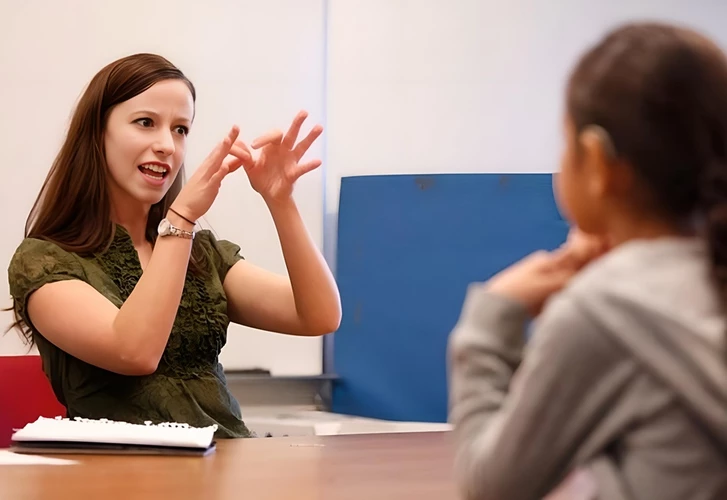BAKU, July 22, 2025 — In today’s society, sign language is far more than a tool for communication — it is a lifeline for thousands of people with hearing impairments. For children especially, the ability to understand and be understood is not a luxury but a foundation for social inclusion, emotional development, and self-confidence. For families of children with hearing loss, learning sign language becomes a vital part of everyday life, strengthening bonds and opening doors to active participation in society.
Media.Az explores the state of sign language accessibility in Azerbaijan — from official policies and government-funded programs to grassroots efforts and challenges families still face.
Building an Inclusive Environment
The Azerbaijani Ministry of Labor and Social Protection reports that the DOST Center for Inclusive Development and Creativity provides sign language interpretation services to help remove communication barriers and facilitate social integration. The center offers courses in sign language and trains volunteers to support citizens with hearing and speech impairments.
State-supported initiatives include projects like “Surdo-Info”, designed to ensure equal access to information, and “Learning Together for an Inclusive Society”, which offers online sign language instruction through social media platforms. The Social Services Agency also conducts communication therapy and sign language training.
Additionally, the state-backed Surdotv.az video portal hosts films and cartoons with sign language interpretation, making entertainment and educational content more accessible.
Community Voices and Challenges
According to Heydar Ragimli, sign language expert and deputy head of the Public Union for the Support of the Deaf and Hard of Hearing, there have been attempts to launch sign language training projects funded by grants, but the lack of sustained financing has prevented long-term impact.

“We were able to run three groups for 1–2 months using grant funding,” he tells Media.Az. “These efforts showed good results at the basic level, but sustainable programs require consistent funding to support instructors and maintain accessibility.”
A valuable free resource, Jestdili.az, provides video materials translating approximately 4,000 Azerbaijani words and expressions into sign language. This digital dictionary is available to anyone at no cost, allowing individuals and families to study anytime, anywhere.
However, Ragimli emphasizes a significant challenge: “Azerbaijan lacks enough trained specialists. Most people learn sign language informally — at school, at work, or within families. While there’s no age limit to learning, early education is most effective.”
Shortage of Qualified Educators
Davud Ragimli, chairman of the Union of Disabled Persons Organizations of Azerbaijan, also spoke with Media.Az about the educational challenges. He notes that although there are specialized schools and boarding institutions, access to quality sign-language-based education is limited. Public schools often lack qualified personnel who can teach or communicate using sign language.

“There are only sign language programs for early grades. Older students and parents have virtually no access to educational content,” Ragimli explains. “Until recently, sign language was not formally recognized as part of the education system. But a 2024 presidential decree by President Ilham Aliyev, calling for the development of a national sign language program, marks a hopeful turning point.”
Early Diagnosis and Regional Disparities
In Baku, specialized clinics and rehabilitation centers offer early hearing screenings. However, outside the capital, access to diagnostic services remains limited.
“Parents often have to travel to Baku for proper screening and hearing aids,” says Ragimli. “This places an enormous burden on low-income families. Though hearing issues can sometimes be noticed within a few months after birth, this isn’t true early diagnosis — and many children are diagnosed far too late.”
He also highlights the lack of educational centers in rural areas, which restricts opportunities for hearing-impaired children. Parental concerns about sending children far from home further isolate them from education and social interaction.
Policy Milestones and Legal Recognition
The Union of Disabled Persons Organizations has implemented several programs since 2013 aimed at officially recognizing Azerbaijani Sign Language. These efforts, supported by both local NGOs and international conventions like the UN Convention on the Rights of Persons with Disabilities, have produced concrete results.
On March 7, 2025, Azerbaijan’s Parliament officially recognized Azerbaijani Sign Language as one of the country’s communication languages. Work is now underway to develop a standardized alphabet and train qualified instructors, signaling a major step toward institutional support.
Paid Alternatives and Accessibility Gaps
While there are private courses in Baku offering sign language training — costing anywhere from 40 to 60 AZN per month — or up to 600 AZN for full courses, these programs are often out of reach for families with limited financial resources. They are primarily geared toward professionals such as teachers, social workers, or future interpreters.
That’s why free platforms and nonprofit-led initiatives remain essential. Their presence ensures that families are not left behind due to financial constraints and that the right to communication remains universal.
Conclusion: Azerbaijan is making meaningful strides toward an inclusive society for the hearing-impaired, but challenges remain — especially in funding, educator training, and rural access. With both government commitment and grassroots dedication, the foundation is being laid for a future where no child is left unheard.










